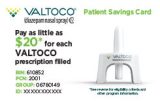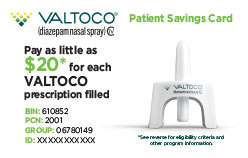
Flexible support for you, your patients, and their care partners
myNEURELIS® is a savings and support program
It allows patients, care partners, and healthcare providers to personally select desired support services. Enroll at myNEURELIS.com to receive myNeurelis services throughout the treatment journey.
Personally select desired support services
- Tailored to the individual needs of patients and their care partners
- Self-enrollment into myNEURELIS services is available via the website
- Dedicated case managers can direct you to resources to learn more about VALTOCO
Supporting your VALTOCO users with nurse educators
- Virtual training on VALTOCO administration
- Educational call series program available
- Staff of registered nurses available by telephone in nonemergency situations who:
- Encourage development of seizure action plans with healthcare providers
- Regularly review plans to ensure understanding
- Nurse educators are also available to answer any nonmedical questions about VALTOCO
Helping patients access VALTOCO
- Insurance coverage check
- Patient assistance program
Your patients may pay less with a VALTOCO copay card
Eligible patients with commercial insurance who qualify may pay as little as $20. No enrollment is necessary.
Request a copay card for eligible patients
If you have any questions about the copay card program, contact your Territory Manager or call myNEURELIS at 1-866-696-3873.
Common insurance copay amounts for VALTOCO
Commercial*
- Copay average is $40
- VALTOCO has a copay program for eligible patients to pay as little as $20†
Medicaid*
- $8 or less
Medicare Part D*
- Full Benefit Dual Eligible patients and Full Subsidy Low-Income Subsidy patients pay $12.15 or less
- Standard Medicare copays can vary


*Patient copays may vary based on insurance plan design and deductibles. Copay program applicable to commercial insurance plans.
†For commercially insured patients only. Must meet eligibility criteria.
For patients without insurance coverage for VALTOCO:
Eligible patients who do not have prescription coverage for VALTOCO and lack the financial resources to pay for their medicine may be able to receive their VALTOCO at no cost through the myNEURELIS® patient assistance program.
For additional information, please contact myNEURELIS at 1-866-696-3873 or visit myNEURELIS.com.

Your patients and their care partners can enroll at myNEURELIS.com or by calling 1-866-myNEURELIS (1-866-696-3873) Monday through Friday, 8 AM to 8 PM ET
Your patients and their care partners can enroll at myNEURELIS.com or by calling
1-866-myNEURELIS (1-866-696-3873)
Monday through Friday, 8 AM to 8 PM ET